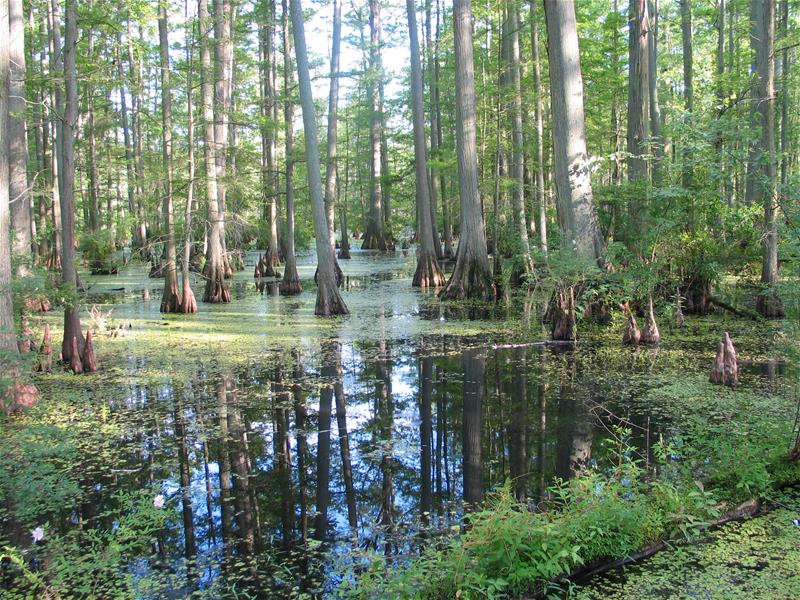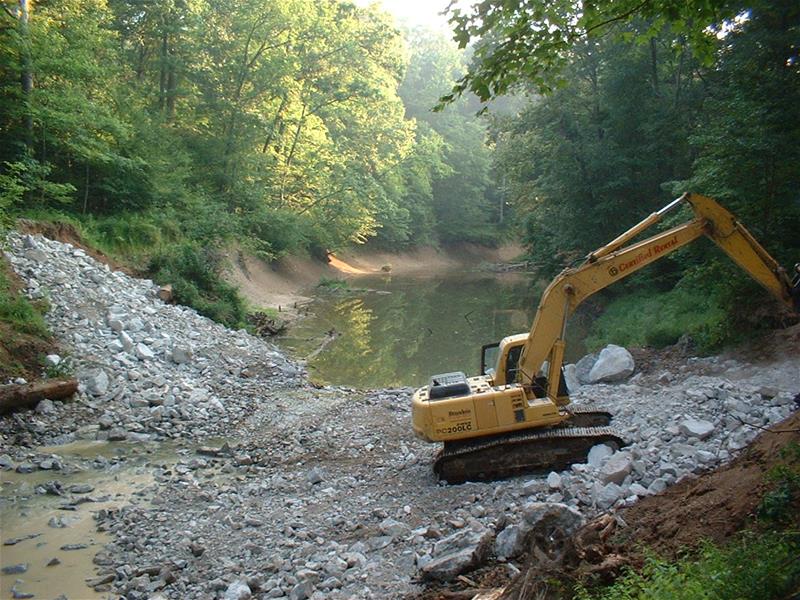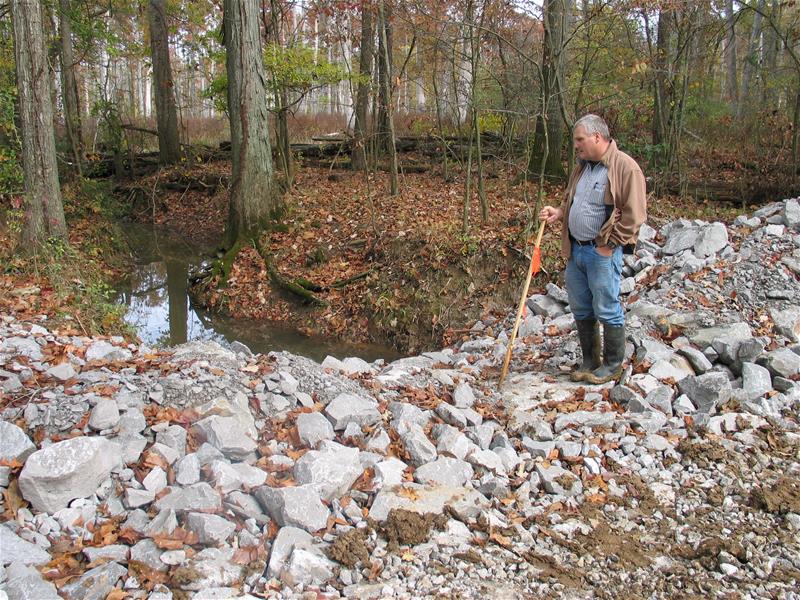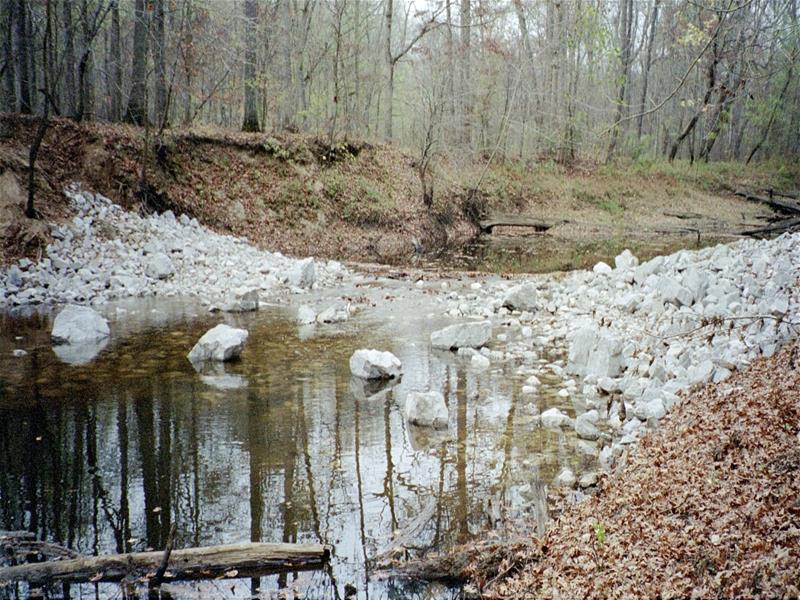Principal Investigators: Don Roseboom, William P. White
Project Staff: John Beardsley, Jon Rodsater, Long Duong
Sponsor: Illinois Department of Natural Resources, United States Fish and Wildlife, Natural Resources Conservation Service
Project Period: 2001, 2003 - 2004

The Cache River Watershed in southern Illinois is unique and listed as a “Wetland of International Importance" (see Cache River/Cypress Creek USA's 15th Designation and Cache River State Natural Area). Channelization of the Cache River along with other alterations to the natural hydrology, habitat fragmentation and excessive erosion and water pollution have been issues that local, state, and federal interests have been trying to collectively combat for years. At the time the Illinois State Water Survey (ISWS) was under the Office of Scientific Research and Analysis at the Illinois Department of Natural Resources. During that period the ISWS was asked to design and install structures to counteract the negative effects of channel down-cutting in an effort to save the precious wetlands. The ISWS Watershed Science Section modified designs, sited, and supervised the construction of the pool and riffle structures in the Cache River.

Findings to Date:
Twenty five (25) pool and riffle structures were installed utilizing 29,000 tons of rock. In addition, several gully plugs were installed in gully locations threatening to undermine near channel wetlands. The structures are working as intended to naturalize stream flow and prevent erosion of the channel bed which further protects the adjacent and highly rich wetlands from being drained. The effort also provided pools behind the riffles which dissipate energy and decrease the amount of sediment and overall water pollution being contributed from stream erosion. The riffles also provide habitat for macroinvertebrates (aquatic insects), fish and other aquatic species, and oxygenates the water to help further improve overall water quality. Implementation of these and other restoration efforts in recent years has helped guarantee that this great natural resource can be preserved for generations to come. An inspection in 2017 of 20 riffle structures revealed that they were still intact and functioning despite past extreme storm events near 20000 cubic feet per second (see USGS 03612000 Cache River at Forman, Illinois).

Project Documents/Publications:
Project documents submitted to Illinois Department of Natural Resources.

Related Publications:
Bonjour Sophia, Heidi Rantala, Micah G. Bennett, Matt R. Whiles, 2018, Fish Community Structure and Diet Responses to Newbury Weirs in a Low-Gradient River, Environmental Management, DOI:10.1007/s00267-018-1022-9.
Bouska Kristen, Timothy J. Stoebner, 2014, Characterizing Geomorphic Change from Anthropogenic Disturbances to Inform Restoration in the Upper Cache River, Journal of the American Water Resources Association (JAWRA) 1-12. DOI: 10.1111/jawr.12266.
Bouska Kristen L., Gregory Whitledge, 2014, Habitat Associations of Fish Assemblages in the Cache River, Illinois, Environmental Biology of Fishes, DOI 10.1007/s10641-013-0120-z.
Heinrich Kaleb K., Matt R. Whiles, Charlotte Roy, 2013, Cascading Ecological Responses to an In-Stream Restoration Project in a Midwestern River, Restoration Ecology Vol. 22 Issue 1, DOI:10.1111/rec.12026.
Bouska, Kristen, Kimberly Erndt-Pitcher, Alicia Lloyd, Amanda Nelson, Timothy Stoebner, 2012, Challenges to Integrating Human and Natural Systems: An Assessment of the Cache River Watershed, Southern Illinois University, Carbondale, Illinois.
Treacy Terri, 9/2/2011, Restoration in the Cache River Watershed, Illinois Chapter Sierra Club.
Treacy Terri, 8/18/2011, The Cache: A Disconnected River, Illinois Chapter Sierra Club.
Treacy Terri, 8/12/2011, The Post Creek Cutoff Ditch Changes the Cache River Forever, Illinois Chapter Sierra Club.
Heinrich Kaleb, 2011, Insect Emergence and Riparian Bird Responses to Rock Weir Construction in the Cache River Basin of Southern Illinois, Thesis, Southern Illinois University, Carbondale, Illinois.
Treacy Terri, 7/22/2011, The Age of Ditching and Draining and Devastating Damage to the Ecosystem of the Cache River Watershed, Illinois Chapter Sierra Club.
Treacy Terri, 7/14/2011, Cache River Watershed Before the Dawn of Ditching and Draining, Illinois Chapter Sierra Club.
Demissie Misganaw, Elias G. Bekele, Yanqing Lian, Laura Keefer, 2010, Hydrologic and Hydraulic Modeling for Evaluating Alternatives for Managed Connection of the Upper and Lower Cache Rivers, Illinois State Water Survey, Champaign, Illinois.
Hoover Jeffrey P., 2009, Effects of Hydrologic Restoration on Birds Breeding in Forested Wetlands, Wetlands, Vol. 29, NO. 2 June 2009, pp. 563-573.
Starr Ellen, Mark Guetersloh, 2009, Hydrologic Restoration Provides Immediate Benefits for Wetland Dependent Species, University of Florida’s Institute of Food and Agricultural Sciences.
Hoover Jeffrey P., 2008, Using Stable-isotopes in Bird Feathers to Assess the Benefits of Local Conservation Actions, Technical Report 2008(37), Illinois Natural History Survey, Champaign, Illinois.
Hoover Jeffrey P., 2008, Effects of Off-channel Wetland Restoration on Breeding Bird Communities, Technical Report 2008(12), Illinois Natural History Survey, Champaign, Illinois.
Demissie Misganaw, Laura Keefer, Yanqing Lian, Feng Yue, Brad D. Larson, 2008, Hydrologic and Hydraulic Modeling and Analyses for the Cache River for the Purposes of Evaluating Current Conditions and Alternative Restoration Measures, Illinois State Water Survey, Champaign, Illinois.
Walther Denise A., Matt R. Whiles, 2008, Macroinvertebrate Responses to Constructed Riffles in the Cache River, USA, Springer Science and Business Media, LLC.
Walther Denise A., Matt R. Whiles, 2007, Macroinvertebrate Responses to In-stream Restoration Structures in a Midwestern River, POSTER/paper PS 67-140, Southern Illinois University, Carbondale, Illinois. Presented at the Ecological Society of America/SER 2007 joint meeting in San Jose, CA.
Thomas David L., Roman Rakitov, Sindhu Krishnankutty, Jeff Hover, Michael R. Jeffords, Darrel Cox, Andrew Miller, Carolyn Nixon, 2006, Illinois Natural History Survey Reports, Illinois Natural History Survey, Urbana-Champaign, Illinois.
Walther Denise A., Matt R. Whiles, 2005, Assessment of Instream Restoration in the Cache River, Illinois: Macroinvertebrate Community Structure on Rock Weirs Compared to Snag and Streambed Habitats, American Geophysical Union, 2005AGUSMNB32A..02W
Gough Steve, 2005, Historic and Prehistoric Hydrology of the Cache River, Illinois, Little River Research & Design, Murphysboro, Illinois.
Rees Jill, Ellen Starr, 2004, Restoration Effort Protects Wetlands: Rare Habitats Endure with Help from NRCS's Wildlife Habitat Incentives Program (WHIP), United States Department of Agriculture Natural Resources Conservation Service.
Contributors: Jane Adams, Jeffrey Beaulieu, David Bennett, Leslie Duram, Steven Kraft, Christopher Lant, Tim Loftus, John Nicklow, and J. B. Ruhl, 2001, Ecological Restoration in Multiple-Ownership Watersheds: The Case of the Cache River in Illinois - Social and Economic Issues, Southern Illinois University, Carbondale, Illinois, in Proceedings of the 2001 Governor's Conference on the Management of the Illinois River.
Cache River Basin: an Inventory of the Region's Resources, 1997, Illinois Department of Natural Resources, Springfield, Illinois.
Demissie Misganaw, Abiola Akanbi, Abdul Khan, 1997, Hydrologic Modeling of Landscape Functions of Wetlands, Illinois State Water Survey, Champaign, Illinois.
Demissie Misganaw, Abdul Khan, 1993, Influence of Wetlands on Streamflow in Illinois, Illinois State Water Survey, Champaign, Illinois.
Demissie Misganaw, William P. Fitzpatrick, Richard A. Cahill, 1992, Sedimentation in the Cache River Wetlands: Comparison of Two Methods, Illinois State Water Survey, Champaign, Illinois.
Demissie Misganaw, Renjie Xia, 1991, Channel Stabilizing Structures for the Upper Cache River, Illinois State Water Survey, Champaign, Illinois.
Demissie Misganaw, Ta-Wei Soong, Richard L. Allgire, Laura L. Keefer, Rodolfo Camacho, Paul B. Makowski, 1990, Appendices for Volumes 1 and 2: Cache River Basin: Hydrology, Hydraulics, and Sediment Transport, Illinois State Water Survey, Champaign, Illinois.
Demissie Misganaw, Ta-Wei Soong, Rodolfo Camacho, 1990, Cache River Basin: Hydrology, Hydraulics, and Sediment Transport: Volume 2: Mathematical Modeling, Illinois State Water Survey, Champaign, Illinois.
Demissie Misganaw, Ta-Wei Soong, Laura L. Keefer, Richard L. Allgire, Paul B. Makowski, 1990, Cache River Basin: Hydrology, Hydraulics, and Sediment Transport: Volume 1: Background, Data Collection, and Analysis, Illinois State Water Survey, Champaign, Illinois.
Demissie Misganaw, 1989, Sediment Yield and Accumulation in the Lower Cache River, Illinois State Water Survey, Champaign, Illinois.
Demissie Misganaw, Paul B. Makowski, Ta-Wei Soong, Nani G. Bhowmik, 1987, Cache River Basin Project: Progress Report, Illinois State Water Survey, Champaign, Illinois.
Demissie Misganaw, Nani G. Bhowmik, 1985, Cache River Basin Study: Progress Report and Project Design, Illinois State Water Survey, Champaign, Illinois.
Report of Board of Cache River Drainage Commissioners of Illinois, 1905, Illinois Printing Company, Danville, Illinois
